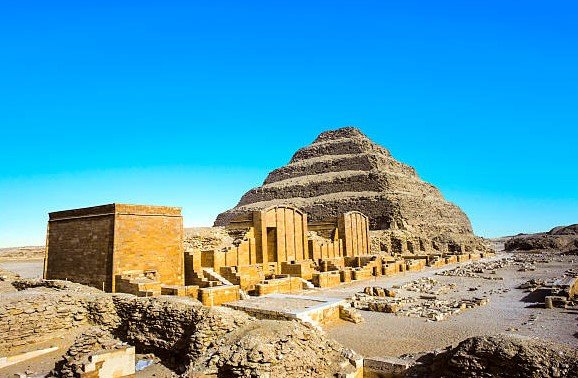Egyptian officials announced on October 6, 2025, that a valuable limestone painting from the pharaonic era has disappeared from the Saqqara necropolis near Cairo. The artwork, part of the ancient tomb of Khentika, marks another loss in a nation famous for its vast historical treasures, sparking an urgent investigation into how it vanished from a site unopened since 2019.
Details of the Disappearance
The missing painting comes from the mastaba tomb of Khentika, a high-ranking official during Egypt’s Old Kingdom. This flat-roofed structure dates back to the sixth dynasty, around 2325 to 2150 BC, and features intricate wall art that showcases daily life and religious beliefs of the time.
Authorities first noticed the absence in May 2025 when a British archaeological team visited the site. Mohamed Ismail, secretary-general of the Supreme Council of Antiquities, confirmed the loss and stated that prosecutors are now probing the case. Reports suggest the painting depicted the ancient Egyptian calendar, divided into three seasons tied to the Nile River’s cycles: Akhet for flooding, Peret for planting, and Shemu for harvest.
No signs of forced entry appeared in initial checks, raising questions about internal access or long-term theft. The tomb had served as a storage area for other artifacts, which might have allowed unauthorized entry over the years.
Experts believe the artwork’s value on the black market could reach millions, given its rarity and condition. Similar pieces from Saqqara have fetched high prices at illegal auctions in Europe and Asia.

Historical Importance of the Khentika Tomb
The tomb of Khentika stands out in Saqqara, a vast burial ground that served as the necropolis for the ancient capital of Memphis. Discovered in the 1950s by British Egyptologist Harry James, it includes unique features like a curse inscription on its facade, warning intruders of punishment by crocodiles or divine wrath.
This curse, one of the few known in mastaba tombs, adds to the site’s mystique. The painting itself illustrated seasonal activities, providing insights into how ancient Egyptians organized time around agriculture and the Nile’s rhythms.
Saqqara holds other treasures, such as the Step Pyramid of Djoser, the oldest known pyramid built around 2630 BC. Recent excavations have uncovered mummification workshops and colorful reliefs, highlighting the area’s role in understanding Old Kingdom society.
Archaeologists value these sites for their well-preserved art, which often shows scribes, farmers, and rituals. The loss disrupts ongoing studies that aim to piece together daily life from over 4,000 years ago.
In 2023, teams found two large mummification workshops nearby, revealing tools and embalming materials that shed light on ancient funeral practices.
Ongoing Investigation and Official Response
Egypt’s Ministry of Tourism and Antiquities has launched a full probe, involving local police and international experts. Officials sealed the tomb after the discovery and are reviewing security footage from nearby areas, though the site lacks modern surveillance in many spots.
Prosecutors question staff and recent visitors, focusing on any lapses in protocol. Ismail emphasized that the council takes such incidents seriously, vowing to recover the piece and prevent future thefts.
International organizations like UNESCO have offered support, urging better protection for Egypt’s heritage. This case follows a pattern of artifact losses, including a stolen bracelet from the Egyptian Museum in Cairo earlier in 2025.
Public outrage has grown on social media, with users calling for stricter laws and technology like AI-monitored cameras at key sites.
Broader Issues with Artifact Thefts in Egypt
Egypt has faced ongoing challenges with looting and smuggling, fueled by political instability and economic pressures. Since the 2011 revolution, reports of thefts have risen, with thousands of items believed missing from museums and digs.
Key factors contributing to these problems include:
- Weak security at remote sites like Saqqara, where vast areas are hard to patrol.
- High demand from private collectors, driving a black market worth billions annually.
- Internal corruption, as some cases involve insiders facilitating removals.
- Climate change effects, such as rising groundwater, which damage sites and create excuses for unauthorized access.
Recent efforts include a 2024 law increasing penalties for smuggling, with prison terms up to 25 years. Egypt also repatriated over 5,000 artifacts from abroad in the past two years, including pieces from the US and UK.
Recent Discoveries and Future Protections
Despite the setback, Saqqara continues to yield finds that excite the world. In September 2025, archaeologists uncovered a colorful tomb with painted walls showing nobleman Khuwy from the fifth dynasty, challenging ideas about Old Kingdom art styles.
These breakthroughs underscore the need for better safeguards. Experts recommend:
- Installing advanced sensors and drones for monitoring.
- Boosting international partnerships to track stolen goods.
- Educating locals on heritage value to reduce community involvement in looting.
A timeline of major events at Saqqara highlights its ongoing significance:
| Year | Event |
|---|---|
| 2630 BC | Construction of Step Pyramid of Djoser begins. |
| 1950s | Discovery of Khentika tomb with curse inscription. |
| 2019 | Last official opening of Khentika tomb. |
| 2023 | Unearthing of mummification workshops. |
| May 2025 | British team notices missing painting. |
| October 2025 | Official announcement and investigation launch. |
This table shows how Saqqara remains a hub of activity, blending ancient wonders with modern challenges.
As investigations continue, the loss reminds us of the fragile balance between preserving history and protecting it from harm. Share your thoughts on how Egypt can safeguard its treasures in the comments below, and spread this story to raise awareness.
